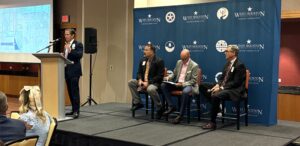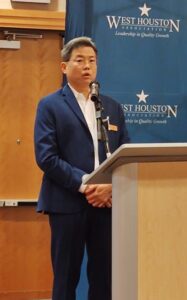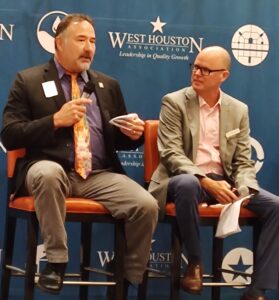 The “Partnership in Flood Risk Mitigation Forum” underscored the critical role of collaboration among all levels of government and the private sector in the successful execution of flood mitigation projects. Two case studies were presented to illustrate this point, and then a panel consisting of Scott Elmer, Steve Costello, and Alan Black discussed the themes that came up in each project.
The “Partnership in Flood Risk Mitigation Forum” underscored the critical role of collaboration among all levels of government and the private sector in the successful execution of flood mitigation projects. Two case studies were presented to illustrate this point, and then a panel consisting of Scott Elmer, Steve Costello, and Alan Black discussed the themes that came up in each project.
The first case study highlighted a unique public-private partnership in the development of The Grand Prairie. Harry Masterson of EMBER Real Estate Investment & Development, detailed how collaboration with the Harris County Flood Control District (HCFCD) enabled the integration of flood mitigation needs for a new development with those of the Cypress Creek overflow area. This partnership resulted in the construction of a single stormwater detention basin serving both needs. Alan Black noted that the initial phase involved “extensive discussions” to clarify the roles and responsibilities of public and private entities. For instance, public funds necessitated contributions based on publicly bid unit prices, and right-of-way (ROW) costs were determined by fair market appraisals. Through these negotiations, common ground was found, leading to a successful project outcome. Scott Elmer emphasized that the HCFCD actively encourages such partnerships when funding is available and further engages with the development community through initiatives like the Langham Creek and Little Cypress Creek Frontier Programs.
 Steve Costello shared two examples where the City of Houston collaborated with private property owners for flood risk mitigation. In one instance, a property near a school was taken off the market by the owner, allowing the City time to formulate a proposal. The City acquired the land at a discounted rate, using part of it for detention while selling the remainder to offset costs. In another case, Shell sold land adjacent to Willow Waterhole to the City at a nominal price. As Costello put it, “they basically gave it to us.”
Steve Costello shared two examples where the City of Houston collaborated with private property owners for flood risk mitigation. In one instance, a property near a school was taken off the market by the owner, allowing the City time to formulate a proposal. The City acquired the land at a discounted rate, using part of it for detention while selling the remainder to offset costs. In another case, Shell sold land adjacent to Willow Waterhole to the City at a nominal price. As Costello put it, “they basically gave it to us.”
 The forum also addressed the importance of partnerships across local, state, and federal levels. Mayor Andy Chan of Southside Place discussed efforts to secure funding for the HCFCD’s Poor Farm Ditch Project. Initial funding from the 2018 Harris County Bond Program was leveraged to form multiple partnerships. Working closely with Congresswoman Lizzie Fletcher, $9.8 million was obtained through FY22 Community Project Funding. Additional collaboration with State Senators Joan Huffman and John Whitmire, and State Representative Ann Johnson, resulted in securing $16.9 million in state appropriations during the 2023 legislative session. Mayor Chan highlighted the necessity of early engagement with state legislators to avoid the complexities of budget amendments. He expressed gratitude to all state and federal officials involved in securing over $30 million for the project, which is slated to begin construction in 2025. Scott Elmer underscored the importance of effective communication and coordination, including maintaining a “consistent message” and fostering “strong community engagement,” to advance such “public-public-public partnerships.”
The forum also addressed the importance of partnerships across local, state, and federal levels. Mayor Andy Chan of Southside Place discussed efforts to secure funding for the HCFCD’s Poor Farm Ditch Project. Initial funding from the 2018 Harris County Bond Program was leveraged to form multiple partnerships. Working closely with Congresswoman Lizzie Fletcher, $9.8 million was obtained through FY22 Community Project Funding. Additional collaboration with State Senators Joan Huffman and John Whitmire, and State Representative Ann Johnson, resulted in securing $16.9 million in state appropriations during the 2023 legislative session. Mayor Chan highlighted the necessity of early engagement with state legislators to avoid the complexities of budget amendments. He expressed gratitude to all state and federal officials involved in securing over $30 million for the project, which is slated to begin construction in 2025. Scott Elmer underscored the importance of effective communication and coordination, including maintaining a “consistent message” and fostering “strong community engagement,” to advance such “public-public-public partnerships.”
The discussion then shifted to navigating the legislative process. Regarding the installation of additional gates at the Lake Houston Dam, Costello explained that the project’s design had to be revised multiple times to meet the stringent requirements for federal (FEMA) grant funding, including achieving a benefit-cost ratio greater than 1.0. This led to extensive advocacy during the 88th legislative session in 2023 for additional state funding, working to avoid Article 11 as “that’s where requests go to die,” and adjustments to existing legislation, ensuring that previously approved funds for Lake Houston could be allocated to the new gates.
 Scott Elmer further elaborated on the challenges of securing federal funding for local projects through the legislative process. He noted that community project funding (earmarks) often comes with significant ambiguity and restrictions. “You have to find a category that aligns with all the statutory requirements of the funding agency. It’s crucial to ensure that your project meets those criteria.” Whether funding comes from federal or state sources, demonstrating public value and aligning project timelines with funding availability is essential.
Scott Elmer further elaborated on the challenges of securing federal funding for local projects through the legislative process. He noted that community project funding (earmarks) often comes with significant ambiguity and restrictions. “You have to find a category that aligns with all the statutory requirements of the funding agency. It’s crucial to ensure that your project meets those criteria.” Whether funding comes from federal or state sources, demonstrating public value and aligning project timelines with funding availability is essential.
Steve Costello wrapped up the event by highlighting the Texas Water Development Board’s recent approval of the first-ever State Flood Plan, which identifies over $50 billion in studies, projects, and strategies across the state. Calling out the state legislators in the room, he pointed out that although the Legislature has allocated hundreds of millions of dollars for flood risk reduction projects in the 2019 and 2023 sessions, substantially more funding is required to advance the plan.
